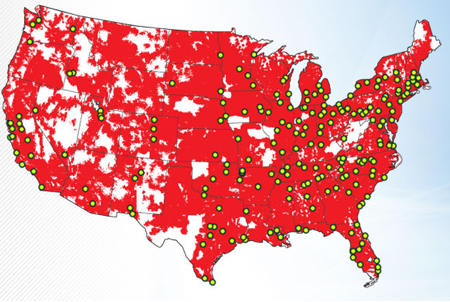The state of 4G LTE: Verizon, Sprint, and AT&T

If you have yet to hear about 4G LTE, chances are you will soon. The buzzword has become a major advertising point for AT&T, Sprint, and Verizon, and all three of the companies are going to be painfully vocal about their progress and intentions on the 4G LTE front in coming months and years.
But buzzword or not, 4G LTE actually means something --though its admittedly not been made very clear what, exactly, that something is. In short, it's this: 4G LTE (also known as 4th generation Long Term Evolution) essentially means speed, more specifically, 5-12 megabytes per second on the download side of things. Compare that to the 3.1 Mbps speeds of the typical 3G network and it should be fairly clear why LTE is such a big deal in our increasingly data-hungry times.
Sprint, Verizon, and AT&T are all in the midst of developing and expanding their LTE networks, and all three have the same general goal: Offer as much coverage to as many people as possible. Lofty intentions, no doubt. Here's a brief look at how the carriers are doing.
See also: Gallery: The 10 best 4G LTE devices on Sprint, AT&T, and Verizon

Verizon is, without a doubt, the most well along of the three carriers. As of April 19th, its 4G LTE network covers 230 markets and two-thirds of the U.S. population. By the end of the year, Verizon says that number will balloon to 260 million people across 400 markets.
As far as phone support goes, Verizon says that all of its phones this year will come equipped to run on its LTE network, which should probably give you a good idea of how serious it is about its efforts. Currently, the carrier offers just over twenty 4G LTE-ready devices, including eleven smartphones, five tablets, a smattering of mobile hotspots, and pair of notebooks.
AT&T
But what AT&T lacks currently in rollout it makes up for in speed, at least according to PCWorld. The publication found that download transfer speeds on AT&T's network averaged at 9.56 Mbps, which was a tad higher than the 7.35 Mbps speeds on Verizon's network. Those numbers may not mean much at this juncture, of course, seeing has how Verizon's network is older and much larger than AT&T's own. That, of course, didn't prevent AT&T from gloating about it.
So far, AT&T offers roughly nine 4G LTE-ready phones, and a trio of tablets, including the iPad.
Sprint
As far as plans go, Sprint says it intends for its LTE network to cover 123 million people by the end of this year, and 250 million by the end of 2013.
That's all well and good, but the fact remains that Sprint's LTE network has yet to launch, and when it does appear it will do so in a fairly limited fashion. Still, there's hope. If Sprint keeps announcing impressive devices like the EVO 4G LTE, the carrier will certainly be able to keep up with the more developed networks of AT&T and Verizon. Or so it hopes.